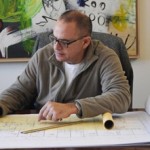Problem With *NOT* Lifting Plane On Return Stroke
Welcome! / Forums / General Woodworking Discussions / Woodworking Methods and Techniques / Problem With *NOT* Lifting Plane On Return Stroke
- This topic has 6 replies, 7 voices, and was last updated 8 years, 2 months ago by
dovetails.
-
AuthorPosts
-
I see Paul, and other woodworkers, drag the plane backwards against the board when making their return stroke. It seems like a good idea – you stay registered against the work piece, and it saves a bit of energy not having to lift the plane off the wood during each back stroke. Regretfully though, I have problems when I try to use this method. When I pull the plane backward, letting it slide against the wood, bits of shavings that haven’t completely ejected through the mouth in the top of the plane, and are slightly protruding from the mouth at the sole, get dragged backwards out of the mouth, and I end up with shavings partly on the sole of the plane, and partly sticking out the mouth in top of the plane. At that point, I have to turn the plane over and pull these shavings out the rest of the way in order to clear the mouth and continue planing. I’ve tried slightly lifting the front or the back of the plane on the return stroke so that the ends of these shavings wouldn’t get snagged on the wood, and get dragged out of the mouth, but have found both methods (lifting the front or the back of the plane slightly off the wood) awkward feeling, and only mildly helpful. I’ve seen another woodworker who tilted the plane right or left so that only the long edge of the plane was touching the wood when he pulled it backwards. This method does work somewhat for me, but I worry that I may make small grooves/furrows in softer woods caused by the edge of the plane cutting into the surface of the work piece. It also doesn’t work when planing the edges of narrow boards – no place to rest the edge of the plane. I’ve heard Paul, in one video (I can’t remember which one), say something about ‘lightening up’ on the plane when he made his return stroke, but other than that, I haven’t any other clues as to what to do to eliminate my problem.
Does anyone have any suggestions? Does anybody else have this problem? When I see folks like Paul, and others, rapidly moving their plane back and forth over the work piece, without lifting the plane off the wood, as I do, it seems like such a fast, efficient way of doing things. I so much want to finally find out what my problem is with performing their technique – once and for all! So any help/suggestions would be greatly appreciated.
Thanks,
Kenny
 7 October 2015 at 6:22 pm #131101
7 October 2015 at 6:22 pm #131101I have the same problem, and have wondered what other people do. I will be watching this thread for sure!

 9 October 2015 at 7:01 pm #131184
9 October 2015 at 7:01 pm #131184I’ve had this issue also and generally I live with it. I doesn’t happen enough for me to worry about. But I really like what Nikon said. I do often lift the back of the plane at the end of a stroke and maybe that’s why I don’t seem to have the issue much. Another benefit of Nikon’s method is this. When you lift the back of the plane at the end of the stroke (and the plane is still on the wood, not off the far end), it feathers the newly planed surface into the previous surface.

I know this is way late.
But I have had the same problem In the past. But I noticed that it only happens when I am making long strokes from one end of the board to the other starting from the back. It is also generally happening on short boards. After studying Paul’s movements as well as his instructions when I start from the front of the board and work my way back and lift the rear tote of the plane up BEFORE i start the backstroke I don’t have that problem. I feel like that it’s because you aren’t trying to plane to a certain place in the board and when you consciously lift the rear of the plane on forward stroke the plane ejects the shaving before you start the backstroke.
-
AuthorPosts
- You must be logged in to reply to this topic.
